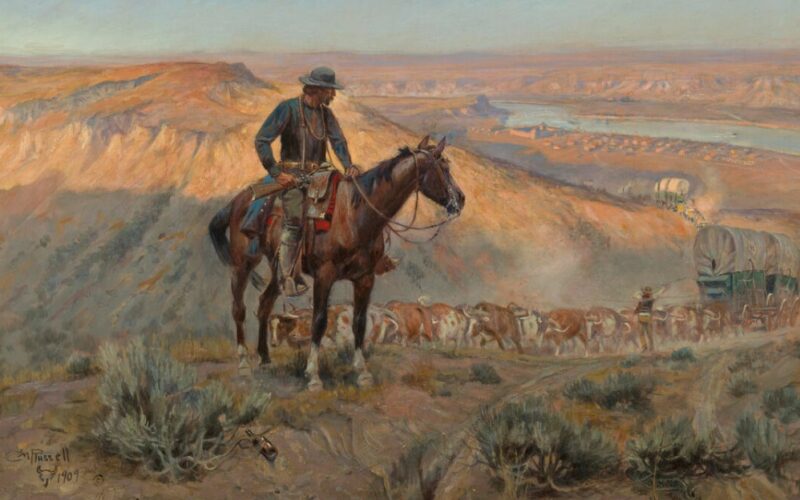Charles Marion Russell Biography and Paintings: The Western artist Charles Russell is known to most art lovers – especially if you are an American West enthusiast. He is one of the best painters of cowboy life in the late 1800s. He is also seen as an artist who portrayed the sophisticated traditions and customs of Native Americans in the 1800s very accurately.
He created more than 2,000 paintings of the American West, and you can find his work in most art museums in the U.S. But, you may want to find out more about Charles Marion Russell and his work.
Therefore, in this article, we’ll briefly discuss his biography and then look at the diversity of paintings he made.
Table of Contents
Western Artist Charles Russell Career
Charles Marion Russell (1864 – 1926) grew up in Missouri, and from a very young age, he drew sketches as well as made clay figures of animals. He was intrigued by the American West and spent hours reading about the “wild west”. When he was 16 years old, he left his home and moved to the Judith Basin area of Montana. There he started to work as a cowpuncher.
He became a cowboy in Montana and also resided for some years with Native Americans. Because of his life as a cowboy and his immersion into the Native American culture and customs, he could depict the period with insight. Throughout his career, he portrayed cowboy life positively and depicted the sophisticated Native American culture he knew in the American West. He worked in the American West for 11 years and, while working, created sketches in his free time. He lived 46 of his 62 years in the American West.
In 1896, Russell married his wife Nancy, and in 1897, they moved to Great Falls, where they spent most of their lives. Nancy setup exhibitions of his work and made him famous in the United States and London.
When Russell died in 1926, all the children in Great Falls were released from school on the day of his funeral to watch the funeral procession. His coffin was displayed in a glass-sided coach pulled by four black horses.
List of Charles Russell Paintings – Categories
Charles Russell was a very “productive” artist. He created more than 2,000 drawings and paintings and, in total, more than 4,000 works of art. To understand the wide spectrum of his paintings, we’ll follow the categorizing method many art historians and scholars use when they study Russell’s work. Of course, there are other ways to look at his work, but this method is, to our mind, the most logical approach.
With this method, Russell’s work is categorized according to the subject matter of his paintings. Although some scholars use other categories as well, we’ll use the following categories for the sake of this article.
Let’s categorize his paintings as works depicting
- cowboy life,
- Native American people, culture, and lifestyle,
- women (Native American women and cowgirls), and
- historical events.
However, some of his paintings don’t fall into any of these categories; in this article, we put them in a category we call “Other”.
Now, look at the different categories and list some of the paintings in each category.
Category 1: Cowboy Life
Although Charles Russell painted various subjects, he is generally known as the “Cowboy painter”. He painted cowboys in various situations.
One of his famous cowboy paintings is a painting depicting a cowboy humorously. “Meat’s Not Meat Till It’s in the Pan” depicts a cowboy who has shot his prey and is now considering how to retrieve his meal-to-be from the outcropping where it has fallen. Russell added an extra level of dark humor to the painting by making it a winter scene with many blue shades.
The following Charles Russell paintings are, apart from “Meat’s Not Meat Till It’s in the Pan”, three of his most famous cowboy paintings:
- “Bronc to Breakfast” (1908),
- “In Without Knocking” (1909), and
- “Laugh Kills Lonesome” (1925)
Category 2: Native American People, Culture, and Lifestyle
Russell’s famous painting, “Indian Buck” (1901), depicts a Native American man. It is believed that Russell’s objective with this artwork was to render homage to the Native American people. He had a unique insight into their culture and customs because he had lived with them for quite a while.
In “Indian Buck”, an adult Native American man wears colorful clothes of leather, fabric, and feather, and he carries something like a rifle wrapped in a hand-crafted leather case. Most art critics, historians, and scholars agree that this painting is a sympathetic portrayal of a Native American man. Read More Tyron Woodley Net Worth: Salary, Endorsements, Contract, Earnings, Records, Charity
Other paintings depicting Native American people, culture, and customs include the following:
- “Mandan Warrior”. This 1906 watercolor depicts a warrior of the Mandan tribe and his horse. Both are in full war regalia.
- “The Marriage Ceremony” (“Indian Love Call”) (1894).
- “Bringing Up the Trail” (1895).
Category 3: Women
Native American women, as well as cowgirls, are subjects of some of Russell’s paintings. When you look at his paintings of Native American women, it becomes clear that he knew the customs of the women quite well.
His 1901 oil on canvas painting of a Native American woman, “Indian Squaw”, is one of his famous works. The painting shows the robust beauty of this particular Native American woman. Interestingly, the term “squaw” usually refers to a Native American woman (a white man’s wife). But in this painting, there is no evidence that Russell meant any degradation of the woman by calling the painting “Indian Squaw”. Instead, she is respectfully depicted when she is standing over an animal hide that is being tanned and then treated. Art critics describe the work as colorful but, at the same time, “peaceful”.
Another painting of Native American women is “Water for Camp”, where Russell depicted the everyday life of Native American women. One of his famous cowgirl paintings is “Cowgirl on a Bucking Horse”.
Category 4: Historical Events
“The Indians discovering Lewis and Clark”, “Lewis and Clark on the Lower Columbia,” and “The Custer Fight” are paintings by Russell depicting historical events in the American West. One of his interesting paintings is “The Attack”. The painting pictures a Native American attack on cowboys, but Russell doesn’t indicate why the attack had been made.
Category 5: Other
“Waiting for a Chinook” was Russell’s first “commercial” work and didn’t fit into one of the four main categories. During the winter of 1886/1887, Russell documented the winter in several watercolors. The ranch foreman where Russell was working at that stage reported to the range owner how the cattle herd had weathered the winter by sending him a postcard-sized watercolor that Russell had painted. The painting depicts wolves watching a gaunt steer. Other ranch owners and art lovers saw the painting and started commissioning work from Russell.
Russell created a more detailed version of the picture on the “postcard” at a later stage, and he called it “Waiting for a Chinook.” Art lovers regard it as one of his most famous watercolors. Paintings such as “Burning Crow Buffalo Range”, “Utica” (“A Quiet day in Utica”), and “Deer in Forest” (“White-Tailed Deer”) are also categorized as “other”.
Conclusion
Charles Russell artist from America, was a successful painter of cowboy life and the culture and customs of the Native American people because he worked and lived in the American West for most of his life. Therefore it is understandable why Charles Russell’s artist is regarded as one of the best painters of cowboy life in the late 1800s and is also seen as an artist who portrayed the sophisticated traditions and customs of Native Americans rather accurately.









